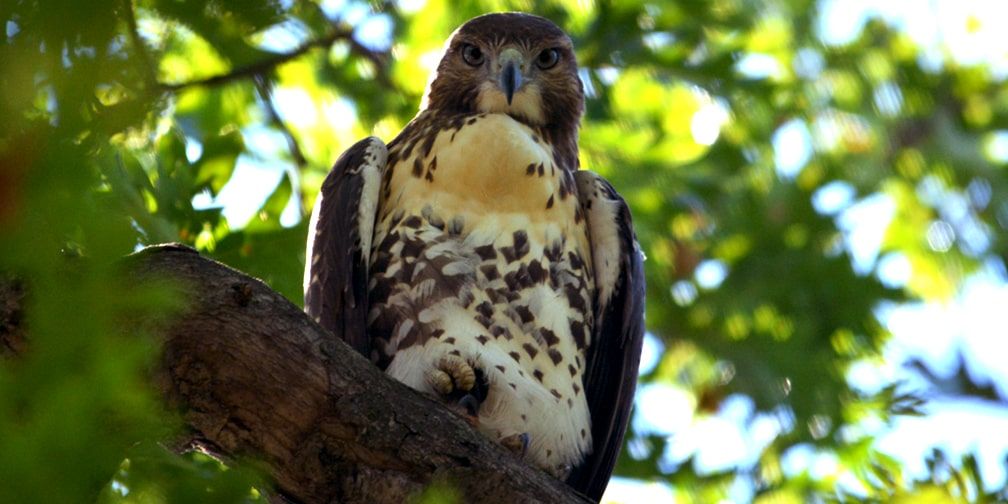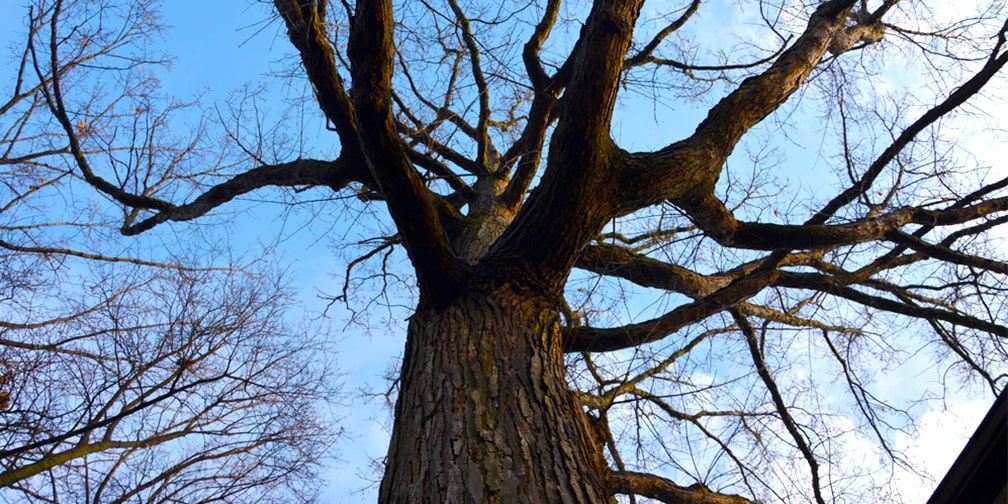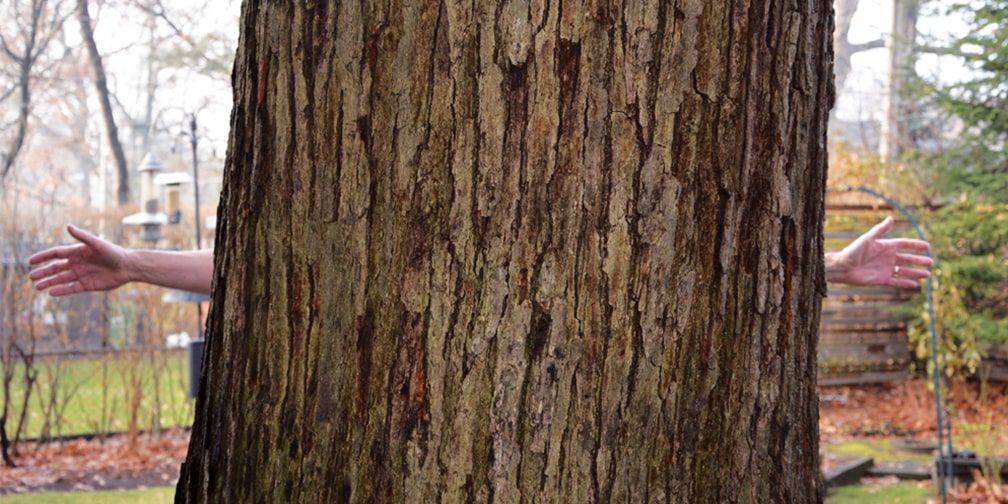Ontario Nature Blog
Receive email alerts about breaking conservation
and environmental news.
© Lora Denis
Our blog this week was written by Mike Badyk, a retired geography and natural history professor and longtime Ontario Nature member.
Thock, thock, thock.
Thock, thock, thock.
It is hard to accurately convey the sound of acorns falling on our roof. You see a giant white oak lets us live with it. It is an experience I certainly wasn’t prepared for.
I grew up with a giant tree in south Etobicoke. I thought I knew life with trees. A huge silver maple (Acer saccharinum) dominated the front of the family home. Fallen leaves beyond imagination and maple keys by the cartload are still lodged in my brain. Still, the silver maple didn’t impose its will like the white oak (Quercus alba) does.
Come late August when the oak acorns ripen, we get a fairly constant “thock, thock” as they fall on our roof. If it is windy they fall all night, but usually it is around 6am when they start. I also know that there is a red squirrel or three up somewhere in the canopy. The reddies, as we call them, start about 30 minutes before dawn. The sound picks up as the grey squirrels join the feast. A bit later it picks up more as the flocks of blue jays, and the grackle gangs, visit.

Another visitor in our white oak, a young red-tailed hawk © Mike Badyk
Ours isn’t the only white oak in the neighbourhood. Part of what attracted us to our neighbourhood is that there are many around us. The presence of the white oaks is related to the diversity of landforms that we have here in Mississauga. We live on top of an ancient sand dune, formed just above the Glacial Lake Iroquois shoreline and on the north side of what must have been a massive Glacial Credit River. The dune is about 1 km long, 300m wide and 30m high. The deep sand covers the typical clays derived from the shales and sandstones of the local bedrock. This makes our neighbourhood much drier than even a block away.
It is said that what you see above ground for a white oak is repeated below ground as their roots reach through the sand for the groundwater. Both white and red oaks are the dominant trees with surprisingly, a good population of huge white spruce planted by the homeowners when our subdivision was built in 1960. I suspect that the original forest cover was a mix of white oak and white pine due to the dry conditions.
Ours isn’t the only patch of white oak in Mississauga. Further south, closer to Lake Ontario, there are extensive sand deposits left behind from underneath Glacial Lake Iroquois. Clarkson and Lorne Park have some magnificent trees. It is widely believed that the famous book “Jalna” by Mazo de la Roche, which tells the tale of the fictional “Whiteoaks Family”, is based on the author’s familiarity with Benares Historical House. Benares, as to be expected, has some impressive white oak trees.
The white oaks are really the giants around here. They are mostly over 100 years old and over 3 metres in circumference and 25 to 35 metres tall. As they are not competing for light in a forest they have spread their branches wide. Our lot is 75 feet wide and our oak greatly exceeds that. When viewed from the street this green wall looms up over the roof of our house. It is even more impressive as our house is up from the street on the crest of the dune.
Acorns are of course an attraction for the local wildlife. We enjoy the squirrels very much as we’ve tried to figure out their behaviour. Grey squirrels chasing each other. Red squirrels chasing each other, and the grey squirrels. Grey squirrels faking that they are burying an acorn. Red squirrels taking offense that another squirrel, no matter the species, exists in the province. Our other name for the red squirrels is “squeaky toys”. It goes on all day long.

View from below © Mike Badyk
Red squirrels spend countless hours transporting acorns along the backyard phone lines to some hidden larder. Chipmunks bounce through the grass and stuff their cheeks to bursting. I’m much less thrilled with the raccoons though. They seem to love the acorns that have fallen in our eaves troughs. I haven’t mentioned that our giant is far too close to the house, only 3 metres away. There has been more than one occasion where I’ve been sitting on the toilet upstairs and a raccoon has been climbing the tree just outside. I don’t care how much of a wildlife lover you might be, but having a raccoon stare at you while you’re doing your private business is disconcerting.
There is a constant rain of acorn shrapnel falling as some animal enjoys yet another nut. You can’t walk barefoot outside with these sharp pieces of shell all over the place. It also necessitates frequent trips up on the house to clean the roof and the eaves troughs and then lots of sweeping of the patio and the driveway. When a vehicle pulls out of a driveway, it sounds like bubble wrap from the popping of the fallen acorns.
Acorns aren’t the only things that drop from the tree. There are of course leaves. We are fortunate that our neighbourhood has the leaves vacuumed by the city – if we get them to the roadside in the autumn. We have tried repeatedly to get the oak leaves to decay. They defy our efforts. They are so waxy and hard, and we are generally so dry that they just don’t break down. Even in winter when we are shoveling snow we encounter leaves that have blown onto the driveway. We joke that you can rake 12 months a year. We do use the leaves to cover our wildflower garden and we push our little electric mower to the limits trying to chop the leaves up to make mulch.
With the huge canopy that the oak creates the back garden has been a horticultural learning experience. The shade we have is dry shade, and tough for a lot of plants. Wild ginger (Asarum canadense) has done well. By contrast we have a lot of trout lilies (both Erythronium americanum – yellow, and Erythronium albidum – white) but they rarely bloom. Much experimentation has given us healthy populations of Great Solomon’s Seal (Polygonatum biflorum), Blood Root (Sanguinaria canadensis), Jack-in-the-Pulpit (Arisaema triphyllum) and Wood Poppy (Stylophorum diphyllum). We also have a few trilliums, white and red, and a small cluster of Wake Robin Trilliums (Trillium sessile) that came with the house. Vegetables and most herbs have been a total failure. Hostas do well, as does lily-of-the-valley.
Adjusting what will grow in the backyard is one thing, but what I wasn’t prepared for were the oak catkins. They are far and away the most difficult aspect that the oak imposes on us. The oak flowers aren’t terribly distinct, mostly little green lumps on black threads. That doesn’t sound so bad does it? What happens is that those little flowers produce pollen in amounts you can’t believe. Everything is coated. You can’t open the windows in May unless there is no wind. Then the flowers fall off. There are tumbleweeds of them on the roof. Again, we make many trips up on the roof, but with an electric leaf blower, accompanied by a dust mask and eye protection. From our experience nothing can clog a downspout like a matted pile of wet catkins. We check the weather forecast and time our roof forays with approaching rain.
Try as we might, we can’t stop the pollen from getting in our rain barrels. We’ve used filters of all sorts to prevent the pollen from contaminating the rainwater but to no avail. Once the weather heats up the pollen starts to decay in the barrel and produces water with a terrible smell that, well, is almost impossible to describe. You will excuse my indelicate words but my brother-in-law has come up with one that is close – roasted diaper. If we are going to get a good rain we hurry outside to drain the barrels and catch fresh odour-free water.
It is interesting, to say the least, to live with these giant trees. However, not everything is perfect in our oaken life. The trees are under a lot of stress. White oaks are a favourite food of gypsy moth caterpillars, which over the past couple of years have built up to plague proportions. Joining in recently are fall cankerworms. In May of 2018 the City of Mississauga had to do aerial spraying of BTK (Bacillus thuringiensis subspecies kurstaki, a naturally occurring bacterium in soil) to knock the insect infestation down and save our part of the urban forest. In hot dry summers we also see signs of stress on our tree. At least the caterpillars were scarce after the spraying this year.
The combination of hungry caterpillars and drought can be lethal even to a tree that is over a hundred years old. We had another giant oak in the front yard. A combination of drought and thousands of gypsy moth caterpillars killed it in 2008. We still miss it. We had a carving done on about 4 metres of the remaining trunk, which is pretty neat, but I’d still rather have the tree. A cross section of the trunk that the arborist left us seems to indicate that the tree was between 120 and 130 years old. It should have lived longer.

© Mike Badyk
Most of the neighbourhood white oaks have been topped. The highest extension of the trunk has either died or been broken in a storm. Ours is no different. Still, our tree looks pretty good, even though I worry. Every couple of years one of the local giant oaks dies. Maybe 120 years is the maximum life span, but I don’t think so. Things are clearly tougher on them now than they have been in the past.
The absence of this tree changed the ecology of the whole front of our property. As we face due south, and there is a south-facing slope, the front lawn was subjected to full sun with the oak shade gone. It promptly died. We tore it all out and started xeriscaping. We have lots of prairie plants and two awesome clusters of native prickly pear cactus (Opuntia humifusa). We have even had garter snakes laying eggs under the junipers. We’ve won awards for our front garden. I’d still rather have the tree.
These white oaks are precious. I’m going to do everything I can to help our white oak live much, much longer. It is worth hanging on to. I hope that our neighbours think the same.
Gananoque Lake Nature Reserve © Smera Sukumar
Mike, what a heart- felt description of the white oak and the busy activities in the urban forest where you live. I can tell that the surroundings bring much contentment to you. I enjoyed the history you shared about the land where you live. I live close to some red oak trees. Some are next to the cemetery where I collect a few acorns and gift to those visiting this magic place. Others are clustered in a grove, within the sanctuary of Bruce Peninsula National Park. I am challenged by your description. Perhaps someone of your ilk has written a description comparable to yours? For now, as a start, it is time to look up oak trees, white and red. I wonder whether red oaks have catkins. There are always questions needing answers in nature. Thanks again for sharing, Jan.